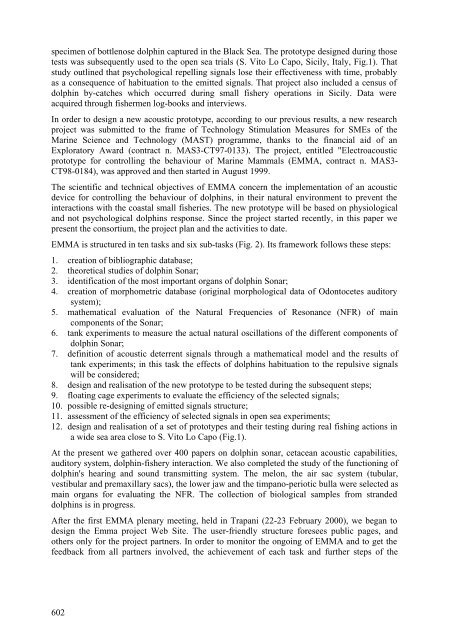EurOCEAN 2000 - Vlaams Instituut voor de Zee
EurOCEAN 2000 - Vlaams Instituut voor de Zee
EurOCEAN 2000 - Vlaams Instituut voor de Zee
Create successful ePaper yourself
Turn your PDF publications into a flip-book with our unique Google optimized e-Paper software.
specimen of bottlenose dolphin captured in the Black Sea. The prototype <strong>de</strong>signed during those<br />
tests was subsequently used to the open sea trials (S. Vito Lo Capo, Sicily, Italy, Fig.1). That<br />
study outlined that psychological repelling signals lose their effectiveness with time, probably<br />
as a consequence of habituation to the emitted signals. That project also inclu<strong>de</strong>d a census of<br />
dolphin by-catches which occurred during small fishery operations in Sicily. Data were<br />
acquired through fishermen log-books and interviews.<br />
In or<strong>de</strong>r to <strong>de</strong>sign a new acoustic prototype, according to our previous results, a new research<br />
project was submitted to the frame of Technology Stimulation Measures for SMEs of the<br />
Marine Science and Technology (MAST) programme, thanks to the financial aid of an<br />
Exploratory Award (contract n. MAS3-CT97-0133). The project, entitled "Electroacoustic<br />
prototype for controlling the behaviour of Marine Mammals (EMMA, contract n. MAS3-<br />
CT98-0184), was approved and then started in August 1999.<br />
The scientific and technical objectives of EMMA concern the implementation of an acoustic<br />
<strong>de</strong>vice for controlling the behaviour of dolphins, in their natural environment to prevent the<br />
interactions with the coastal small fisheries. The new prototype will be based on physiological<br />
and not psychological dolphins response. Since the project started recently, in this paper we<br />
present the consortium, the project plan and the activities to date.<br />
EMMA is structured in ten tasks and six sub-tasks (Fig. 2). Its framework follows these steps:<br />
1. creation of bibliographic database;<br />
2. theoretical studies of dolphin Sonar;<br />
3. i<strong>de</strong>ntification of the most important organs of dolphin Sonar;<br />
4. creation of morphometric database (original morphological data of Odontocetes auditory<br />
system);<br />
5. mathematical evaluation of the Natural Frequencies of Resonance (NFR) of main<br />
components of the Sonar;<br />
6. tank experiments to measure the actual natural oscillations of the different components of<br />
dolphin Sonar;<br />
7. <strong>de</strong>finition of acoustic <strong>de</strong>terrent signals through a mathematical mo<strong>de</strong>l and the results of<br />
tank experiments; in this task the effects of dolphins habituation to the repulsive signals<br />
will be consi<strong>de</strong>red;<br />
8. <strong>de</strong>sign and realisation of the new prototype to be tested during the subsequent steps;<br />
9. floating cage experiments to evaluate the efficiency of the selected signals;<br />
10. possible re-<strong>de</strong>signing of emitted signals structure;<br />
11. assessment of the efficiency of selected signals in open sea experiments;<br />
12. <strong>de</strong>sign and realisation of a set of prototypes and their testing during real fishing actions in<br />
a wi<strong>de</strong> sea area close to S. Vito Lo Capo (Fig.1).<br />
At the present we gathered over 400 papers on dolphin sonar, cetacean acoustic capabilities,<br />
auditory system, dolphin-fishery interaction. We also completed the study of the functioning of<br />
dolphin's hearing and sound transmitting system. The melon, the air sac system (tubular,<br />
vestibular and premaxillary sacs), the lower jaw and the timpano-periotic bulla were selected as<br />
main organs for evaluating the NFR. The collection of biological samples from stran<strong>de</strong>d<br />
dolphins is in progress.<br />
After the first EMMA plenary meeting, held in Trapani (22-23 February <strong>2000</strong>), we began to<br />
<strong>de</strong>sign the Emma project Web Site. The user-friendly structure foresees public pages, and<br />
others only for the project partners. In or<strong>de</strong>r to monitor the ongoing of EMMA and to get the<br />
feedback from all partners involved, the achievement of each task and further steps of the<br />
602

















